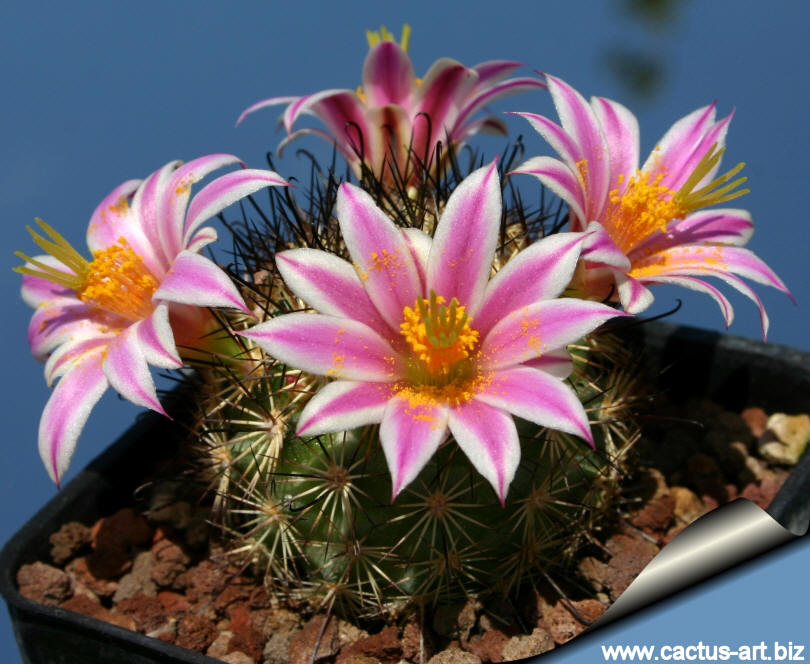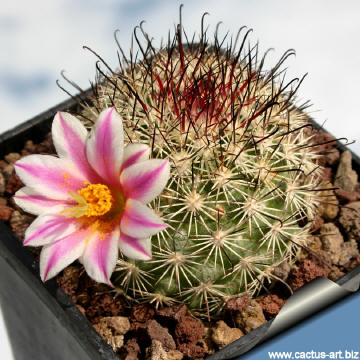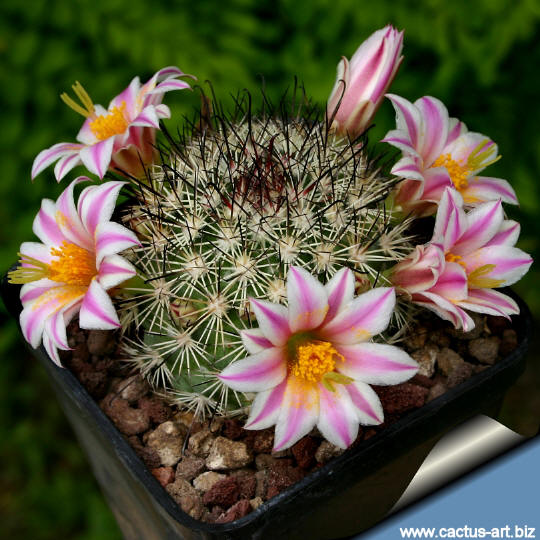|
|
|

Mammillaria blossfeldiana
A tiny, delightful plant with black, hooked, central
spines, and large pink and white flowers.
This slowly
offsetting Mammillaria species is tremendously good-looking;
|
|

Light pink flower, petals with a darker
median line and unusual green
stigma stretched out towards the sun.. |
Description: Mammillaria blossfeldiana
is a rather small plant, usually solitary or slowly branching, with superb showy
flowers.
Stems: Globose to cylindrical, gray-green, 4 - 10 cm high, 3 - 4
cm in diameter, without latex.
Tubercle: Short, conical, 3-5 mm long, about as long as large (or
larger) ± quadrangular at the base. Axil almost naked, or with
a little short wool.
Parastichy number: 8-13.
Radial spine: 11-20 rid, acicular, white-cream or yellowish with
darker tips, 4 - 7 mm long.
Central spine: 3-4, about 8-12 mm long, of which the lowermost one
is erect, dark brown to black, and hooked, while the upper 2 or 3 are
straight, acicular and paler.
Flower: Very showy, broadly infundibuliform, 20 - 40 mm in
diameter. Inner perianth segments are white, with rose to carmine red
mid-ribs, up to 20 mm long, Outer perianth segments
are oblong, obtuse,
solid deep pink to brownish/red with white to cream margins. Filament
is cream-coloured, stigmalobes
are greenish
Fruit: Club-shaped, 14-20 mm long, orange-red to scarlet.
Seed: Black, minutely pitted.
Blooming season (Europe): March-July. |
|
Cultivation:
Like most hooked spined species from Baja California,
this plant
isn't noted for being easy to cultivate, but in good
conditions with excellent
ventilation, it grows without difficulty.
It is especially sensitive to overwatering,
so
careful watering and an open
mineral
potting soil are a must to extend the life of this species.
Avoid
the use of
peat or other
humus sources in the
potting mixture.
Don't add
limestone to the potting mix, which must be moderately acidic.
Can be sensitive to frost. It requires
maximum
sun exposure to reach its full potential,
and to achieve success in
flowering. A winter rest that
allows the plant to shrivel (perhaps losing up to 25% of its summer
height) will encourage flowering and long time survival. Be careful to
encourage slow growth. The careful grower will be rewarded with
generous numbers of large white and pink flowers.
Propagation: Seeds or offsets. |
|
Advertising
|
|
|
|
|
Family:
Cactaceae (Cactus
Family) |
|
Scientific name: Mammillaria
blossfeldiana
First description by Boedeker, Monatsschr. Deutsche
Kakt.-Ges. 3: 209 (1931)
Origin: Mexico, Baja California and Guadalupe and Cedros
Islands) .
Habitat: Arid plains in Lower Sonora
Desert zone in, hot, decomposing granite and gravelly soil. Altitude
below 50 m.
Geographic Distribution:,
Conservation status: Listed in
CITES appendix 2.
|
Synonyms:
- Mammillaria blossfeldiana Bödeker,
Monatschr. Deutsche Kakt.-Ges., 3: 209, 1931
- Mammillaria shurlyana Gates,
Cact. Succ. J. (US), 13: 78, 1941
- Mammillaria blossfeldiana Böd. var. shurlyana
(Gates) Wiggins
in Shreve et Wiggins , Veget. Fl.. Sonoran Desert,
2: 1030, 1964
-
Mammillaria goodridgii
-
Mammillaria goodrichii var. rectispina
-
Mammillaria rectispina,
-
Bartschella blossfeldiana
-
Neomammillaria blossfeldiana
-
Ebnerella blossfeldiana
-
Chilita blossfeldi
|
|
|
|

Very impressive, especially for
the magnificent flowers which appear in
midsummer in cultivation. It flowers freely at an early
age, and is well worth growing.
Best for
full sun to
light shadow.

 |
|